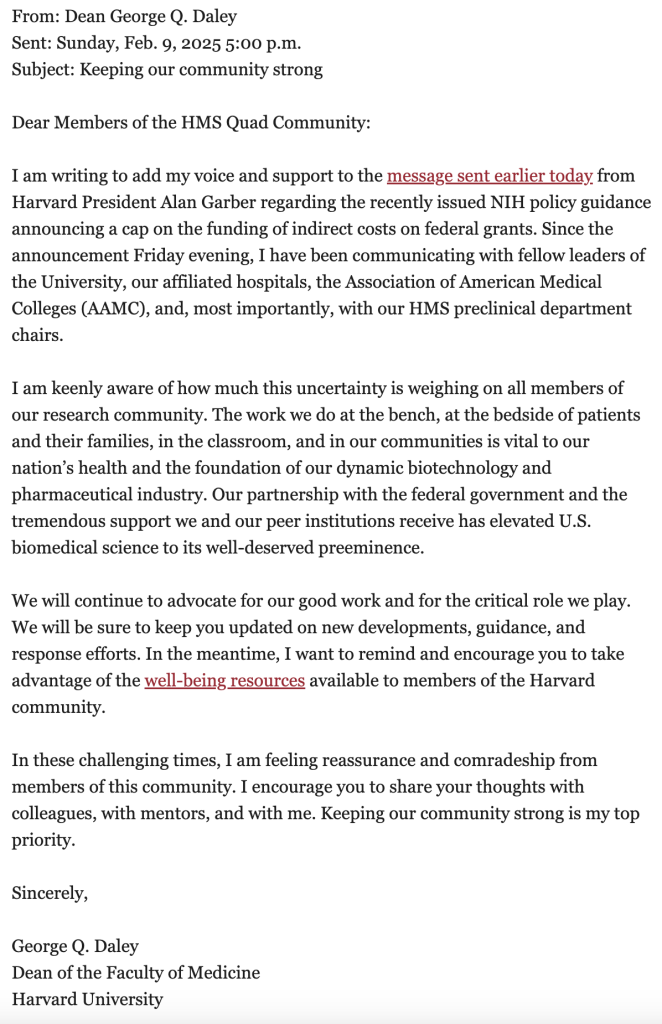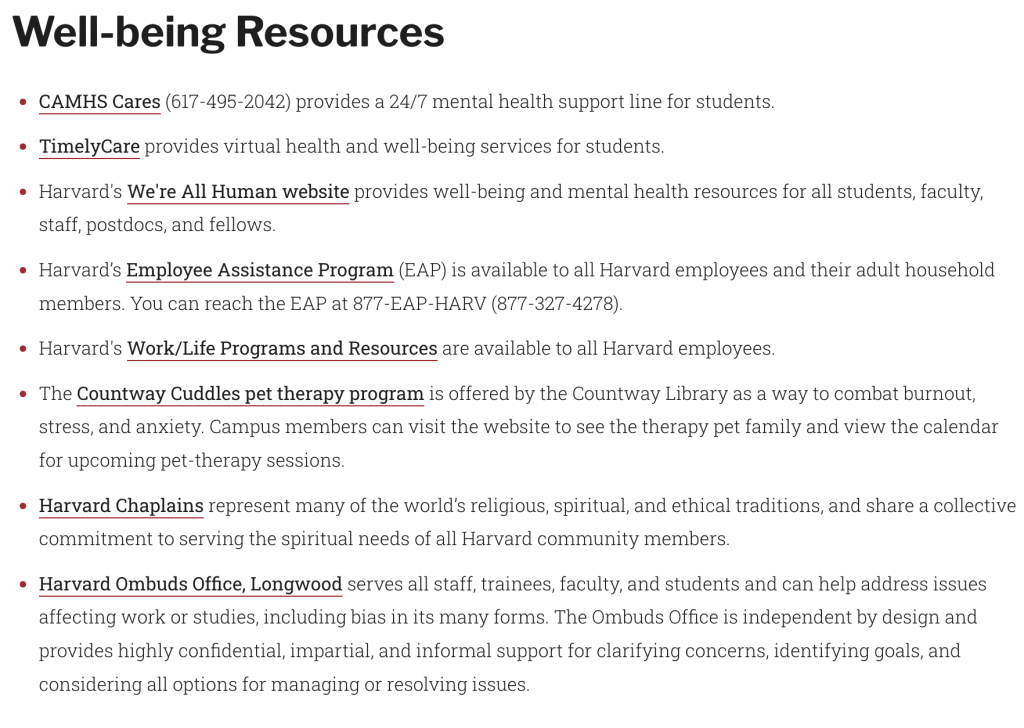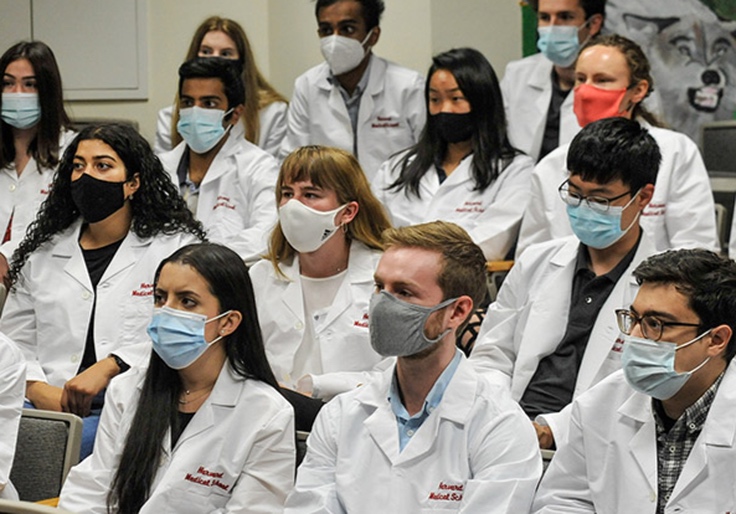Days after President Donald Trump's National Institutes of Health moved to cap government funding for so-called indirect research costs—that is, money tacked on to a research grant that universities use to fund administrative salaries and other expenses—Harvard Medical School sent concerned students and faculty a message encouraging them to "take advantage" of the school's "Countway Cuddles" pet therapy program.
Medical school dean George Daley sent the email to "Members of the HMS Quad Community" on Feb. 9 and forwarded it to the school's alumni two days later, a copy of the message obtained by the Washington Free Beacon shows. In it, Daley cited Trump's "recently issued NIH policy guidance announcing a cap on the funding of indirect costs on federal grants" and said he was "keenly aware of how much this uncertainty is weighing on all members of our research communities."

Daley went on to encourage students, faculty members, and researchers to "take advantage of the well-being resources available to members of the Harvard community." He linked to a page that touts Harvard-funded services like a "24/7 mental health support line" and the "Countway Cuddles pet therapy program," which hosts "pet-therapy sessions" meant to "combat burnout, stress, and anxiety." Attendees can "pet and play" with one of six "therapy animals": "Sophie the Golden Retriever," "Rudy the Golden Retriever," "Sasha the Black Lab," "Bodhi the Yellow Lab/Golden Retriever Mix," "Bao the miniature Goldendoodle," and "Hermie the therapy guinea pig." The program's website includes a guide on the "Right Way to Pet a Dog."

"In these challenging times, I am feeling reassurance and comradeship from members of this community," Daley concludes in his email. "I encourage you to share your thoughts with colleagues, with mentors, and with me."

Daley's message reflects the great lengths elite universities have gone to accommodate delicate students and staff, including at graduate schools filled with adults. Harvard Medical School's most recent incoming class included students no younger than 21 and as old as 34.
The message also reflects the panicked response—both on college campuses and in the media—to the Trump administration's efforts to rein in the use of taxpayer dollars on administrative spending and overhead at U.S. universities.
The NIH's Feb. 7 memo sets a 15 percent cap on "indirect costs" the federal government agrees to fund when it awards a research grant to a university. Under the system, a school that receives a $1 million grant would receive an additional $150,000 to pay for indirect costs associated with the research.
Before the change, individual universities negotiated their own reimbursement rates for indirect costs. Those rates averaged between 27 and 28 percent, according to the NIH, though some schools enjoyed much higher rates. Harvard Medical School's previous rate sat at 69.5 percent, meaning it would receive nearly $700,000 to fund the indirect costs stemming from a $1 million grant.
The grant money covers costs directly associated with a project, like equipment and researcher salaries. The indirect funding covers more general research expenses, like energy bills, computers, waste disposal, building maintenance, and, more controversially, administrative salaries and budgets.
The NIH memo calls those costs "difficult to oversee" and specifically aims at administrative spending. "The United States should have the best medical research in the world," it states. "It is accordingly vital to ensure that as many funds as possible go towards direct scientific research costs rather than administrative overhead."
The memo also notes that private foundations reimburse indirect costs at much lower rates than those previously offered by the federal government. The Gates Foundation, according to the memo, maintains a 10 percent cap on indirect costs, while the Rockefeller Foundation's cap sits at 15 percent. Those foundations pay lower indirect costs, according to the scientific journal Nature, "because historically, universities have had their costs covered by the federal government."
Should the Trump administration prove successful in its bid to end that practice—the new NIH policy is the subject of an ongoing legal challenge—Harvard will have plenty of money to cover indirect costs.
Its endowment, managed by Harvard's in-house hedge fund, Harvard Management Co., is valued at more than $53 billion. In fiscal year 2024, the school's operating expenses totaled $6.4 billion, a 9 percent increase from the year prior that was "driven primarily by higher compensation costs, increased spending on information technology services, and the ongoing maintenance of our campus," according to the Harvard Financial Administration.
Even with those increased costs, Harvard ended the last fiscal year with a $45 million budget surplus. The medical school received more than $171 million in NIH funding during the same period.
Universities have a history of generously interpreting the federal rules surrounding indirect costs. In the 1980s, Stanford University infamously used indirect funding to cover luxuries for then-president Donald Kennedy, including $6,000 for cedar lining in his closets, $2,000 a month for flowers, and $1,000 a month in laundry services. Stanford also used the funds to cover the depreciation of a 72-foot yacht that was donated to the university's sailing program to entertain donors.
Kennedy maintained that the yacht spending was a mistake (federal rules prevent schools from using indirect funds for entertainment), though he defended billing the government for the maintenance of his home, arguing that those expenses were permissible. Stanford repaid the federal government for the superfluous costs, and Kennedy resigned over the scandal in 1991. The University of Pennsylvania responded to the ordeal by voluntarily ceasing its use of indirect funds to maintain its own presidential home. The school said such expenses were legal but widely seen as "not proper," the Associated Press reported at the time.
The Obama administration also attempted to curtail indirect cost spending, having proposed an unspecified flat reimbursement rate for all institutions in 2012. Some economists praised the move, though the Association of American Universities—which represents Harvard, MIT, and other top research institutions—successfully lobbied to kill it.
"Harvard is taking the government to the cleaners," Richard Vedder, an Ohio University economics professor who leads the Center for College Affordability and Productivity, said at the time.
"The amount of taxpayer money that goes to support these private schools is immense," he said. "The federal government should not be in the business of subsidizing building construction or administrative aggrandizement."
A judge temporarily paused the Trump administration's NIH funding change on Monday after 22 states sued to stop it. The administration will argue in favor of the policy during a Feb. 21 hearing.
Harvard did not respond to a request for comment.
